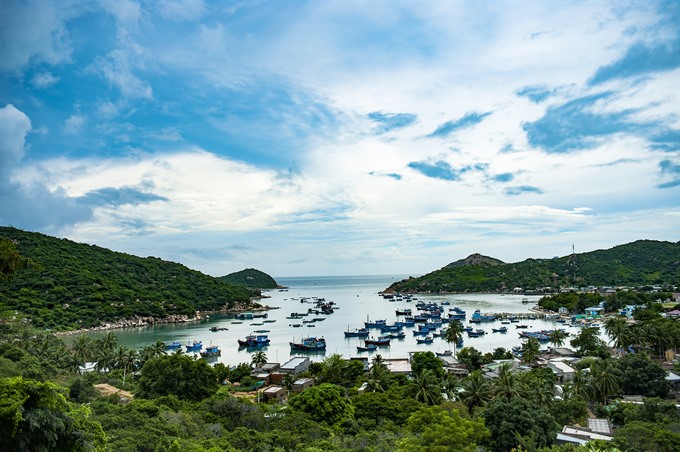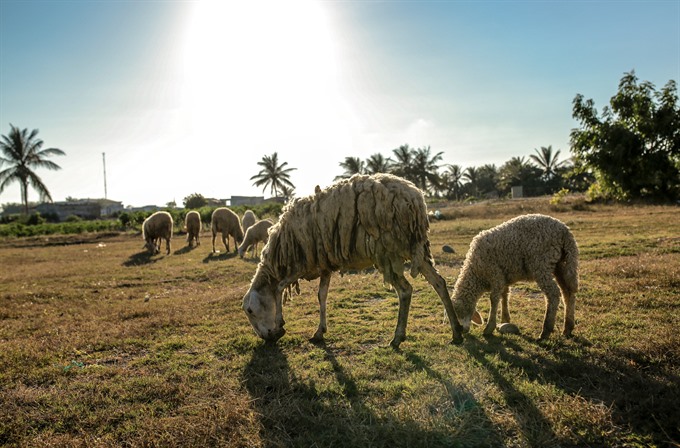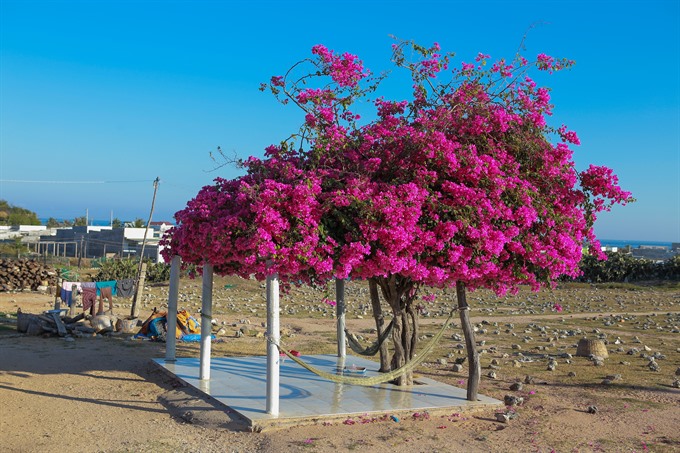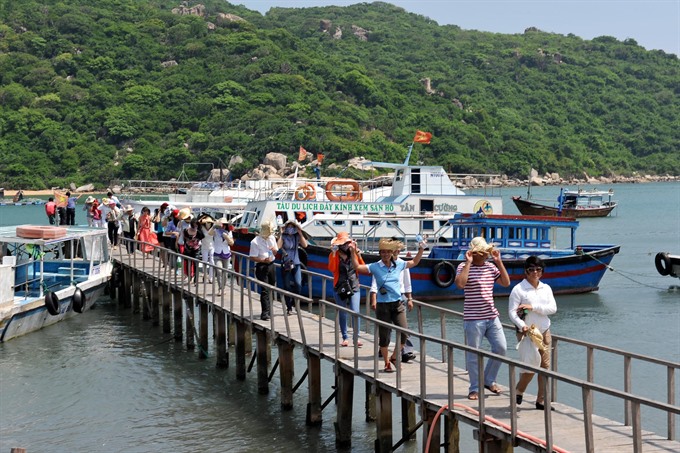Developers are starting to discover the beautiful coastline of Ninh Thuận Province. Go now to experience stunning beaches, delicious seafood, hospitable wineries and much more, before major resort projects transform the area. Bùi Quỳnh Hoa reports.

Serene: Unspoiled and peaceful Vĩnh Hy Bay. VNA/VNS Photo Minh Đức
In Ninh Thuận Province, the sunny and windy land in the south central coast of Việt Nam, it felt like someone had dimmed the bright and shining sun as we made our way to the spectacular sightseeing destinations here.
From Phan Rang City, we followed a road along Ninh Chữ Beach to reach Tri Thủy Bridge, then turned right onto provincial Road 702. After a distance of about 40km down the road — with the sea on one side and green forest at the other — we reached Vĩnh Hy Bay.
Faraway small villages nestled peacefully among mountains and white salt fields dazzled our eyes. Young women were weaving fishing nets and passionately singing songs about their land.
“This is the first time I have come to Vĩnh Hy Bay, but I’m charmed by it right at first sight,” said Dương Thị Kim Oanh, who came from Hà Nội.
“It looks like a beautiful painting. I love nomadic people here also. They are so nice and warm-hearted,” Oanh said.
After taking photographs, we went scuba diving to see the coral forest.
Enjoying fresh seafood on the beach at dawn was another must-do that we could not ignore. We had spanner crabs, sea snails, urchins and oysters. Although they were simply cooked in only three ways — steamed, grilled or raw — they were delicious. The price was affordable, about VNĐ400,000 (US$17) per person, so it was worth the taste.

Sunrise treat: The most impressive moment in Hang Rái comes at dawn when the water changes colour magically as the sun’s creativity runs riot. Photo Tuấn Đào
Celestial views
We went to explore Hang Rái in Thái An Village in Ninh Hải District’s Vĩnh Hải Commune on the next day.
Located within Núi Chúa (God Mountain) National Park, Hang Rái is a rocky outcrop on the coast that offers endless opportunities to gasp at the beauty of sunsets and daybreaks.
Getting there was itself a visual treat, with the coastal road running past innumerable white mounds of salt.
The special terrain of rock piles accumulated over centuries by nature includes many large and small caves that are home to many otters, giving the place its name, Hang Rái or Otter Cave.
The first impression we had on reaching the cave was that we were lost in a poetic painting of water pouring down from the peak of the God Mountain. Pure and crystalline streams were easily seen on the sand.
“It’s amazing to contemplate the beauty of evergreen moss mingling with silvery waves,” said Oanh’s husband, Phạm Tiến Bình. “I feel I’m in the presence of a masterpiece sketched by nature.”

Baaaaa: An Hòa sheep field is a must-see when exploring Ninh Thuận Province. Photo Tuấn Đào
“The moss that gathers densely on coral reef that seems to float on transparent water looks like a humongous jade green gem from afar,” Bình added.
The most impressive moment in the cave came at dawn when the water changed colour magically as the sun’s creativity ran riot. The cliffs etched against the background of a pure blue sky. We took a series of wonderful photos of the moment.
Although a new destination on the Việt Nam travel map, Ninh Thuận does possess a series of untouched and breathtaking landscapes and historical sites.
Top famous attractions include stunning turquoise Ninh Chữ and Bình Tiên beaches, Chàm Towers, Po Klong Gia Rai Towers featuring Champa architectural style and Bãi Tràng, an ideal place for camping.
Sleeping in tents under a night sky full of stars is a memorable experience for sure. Mũi Dinh or Cape Dinh, An Hòa sheep field, Nam Cương sand dunes and Bàu Trúc ceramic village are also a must when exploring the province. But we didn’t have much time, so we decided to save them for our next trip.

Colourful: Blooming and colourful paper flowers from Bougainvillea trees are easily seen everywhere in Ninh Thuận Province, the sunny and windy land in the south central coast of Việt Nam. Photo Tuấn Đào
Models of garden tourism
From Vĩnh Hy Bay, we left for Thái An Village in Vĩnh Hải Commune, one of two largest vineyards in the province, which is considered the country’s largest grape producer.
In the context of global climate change, Ninh Thuận has recently adapted its agricultural production model to drought by growing grapes which earn farmers an encouraging profit and lure a large number of visitors from across the nation and world.
The day we came to a vineyard owned by Nguyễn Thị Phượng in Thái An Village, the sunlight radiated through the vine leaves, creating fanciful emerald patterns and a relaxed atmosphere.
We were very excited to enjoy and buy fresh ripe grapes we picked ourselves, take pictures, taste homemade grape wine and juice and learn about the planting and production process. Along with us, some visitors from other groups even enjoyed a homestay experience and parties right in Phượng’s vineyard.
According to vice chairman of Ninh Hải District’s People’s Committee, Lưu Xuân Hải, Vĩnh Hải Commune has 400 vineyards with a total area of 274ha. All are grown to the VietGap (Vietnamese Good Agricultural Products) standards.
Touring around: Dương Thị Kim Oanh and her husband Phạm Tiến Bình at Thái An vineyard in Ninh Hải District’s Vĩnh Hải Commune. Photo Bùi Quỳnh Hoa
Growing grapes in Ninh Thuận not only helps local farmers overcome the severity of natural conditions on their dry land to survive and make money, but also offers an attractive tourist service.
The Director of the provincial Department of Culture, Sports and Tourism, Châu Thanh Hải, said the province had developed specific measures and a long-term plan to lure visitors to vineyards and to turn it into an attractive destination for people on their journey to explore Ninh Thuận.
He said the province had also instructed relevant agencies to co-operate with research institutes to grow more new grape varieties. Many training courses had also been held to develop the technique of planting “clean” grapes by replacing chemical fertilisers, pesticides and other substances with biological products. Improving foreign language and professional skills in tourism services had also been strengthened, Hải said.
Together with the developing model of vineyard tourism in Thái An Village, tropical fruit gardens in Lâm Sơn Village in Ninh Sơn District are also successful models, switching from growing rice and maize to fruit trees, and earning locals encouraging profits.
According to vice chairman of the Lâm Sơn People’s Committee Đoàn Nhật Vương, Lâm Sơn so far has 800ha of fruit trees, including durian, mangosteen and rambutan trees.
“In peak season (from July to September), the village welcomes about 200 visitors daily and 500 ones each weekend day,” Vương said. “The development of fruit garden tourism helps turnover from planting fruit trees grow four to five times higher than growing rice and maize.”
It will be a struggle to maintain the uniqueness of Ninh Thuận’s landscapes as more resort projects are carried out along the coast. So, if you want to see this yet-unspoiled beautiful coastline and experience garden tourism, now is the time to go. VNS

On the come-up: More and more visitors are coming to Vĩnh Hy Bay to explore the spectacular sightseeing destinations here. VNA/VNS Photo Thanh Hà
Getting there:
You can go to Ninh Thuận Province by motorbike, car, bus or train departing from Hà Nội, HCM City or Đà Nẵng.
- Airplane: Get a flight to Cam Ranh Airport in Nha Trang City; then you can go to the province by car or taxi.
- Train: You can buy tickets at any station of Thống Nhất train. Stop at Tháp Chàm station from where you can take a taxi to Phan Rang City.
- Bus: from HCM City, start at Miền Đông station and stop at Phan Rang station.